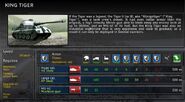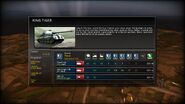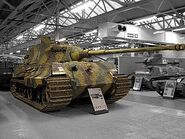| “ | What the hell?! They've got King Tigers! - Kowalski, The Siege of Bastogne |
” |
If the Tiger was a legend, the Panzerkampfwagen Tiger Ausf. B, aka "Königstiger" ("King Tiger", actually "Bengal Tiger"), was a tank crew's dream. It had even better armor than the original, a high velocity 88mm gun able to blow away any enemy tank at up to 3000m, and an MG-42 in its hull. But the King Tiger was also an industrial nightmare that is very expensive and slow to produce; as a result it can only be deployed in limited numbers.
The 'King' Tiger was a formidable tank that could deal with any of its opponents on the battlefield with ease. In total capacities, it weighed over 69,000lbs/68 tons, and was armed with a long barrelled KwK 43 L/71 gun, which could penetrate 132mm/5.19in of armor at 2,000m/6,561ft. It was thus able to deal effortlessly with the heaviest Allied tanks. However, its sheer weight and bulk gave it a relatively poor cross-country performance and made for problems in maintenance and reliability. As stated before, only a total of 489 'King' Tigers were built, and they were used mainly in the defensive battles as the Allies advanced deep into Germany.
The King Tiger is 11 tons heavier than the original Tiger, and that 11 tons is mostly used to thicken it's armour. A combination of thick and sloped armour made it indestructible to most guns at that time. But it used the same Maybach engine as the previous Tiger, so the engine became too ineffective. Combined with the little supply received on the battlefield, it has low mobility; low speed, low axis-turning, and low turret traverse. But speed wasn't much of a problem in 1944, because Germany begins using defensive tactics, and the peak was in Battle of the Bulge, when many King Tigers stationed there is mostly entrenched.
History[]
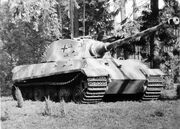
Development of a heavy tank design had been initiated in 1937; the initial design contract was awarded to Henschel. Another contract followed in 1939, and was given to Porsche. Both prototype series used the same turret design from Krupp; the main differences were in the hull, transmission, suspension and automotive features.
The Henschel version used a conventional hull design with sloped armor resembling the layout of the Panther tank. It had a rear mounted engine and used nine steel-tired overlapping road wheels with internal springing per side, mounted on transverse torsion bars, in a similar manner to the original Tiger. To simplify maintenance, however, the wheels were overlapping rather than interleaved as in the Tiger I.
The Porsche hull designs included a rear-mounted turret and a mid-mounted engine. The suspension was the same as on the Jagdpanzer Elefant. This had six road wheels per side mounted in paired bogies sprung with short longitudinal torsion bars that were integral to the wheel pair; this saved internal space and facilitated repairs. One Porsche version had a gasoline-electric hybrid power system; two separate drive trains in series, one per side of the tank, each consisting of a hybrid drive train; gasoline engine – electric generator – electric motor – drive sprocket. This method of propulsion had been attempted before on the Tiger (P) (later Elefant prototypes) and in some U.S. designs, but had never been put into production. The Porsche suspension were later used on a few of the later Jagdtiger tank hunters. Another proposal was to use hydraulic drives. Dr. Porsche's unorthodox designs gathered little favor.
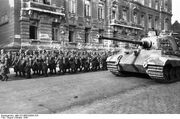
King Tiger driving alongside marching German forces in Hungary.
The Tiger II was developed late in the war and made in relatively small numbers - 1,500 Tiger IIs were ordered, but the production was severely disrupted by Allied bombing. Among others, five raids between 22 September and 7 October 1944 destroyed 95 percent of the floor area of the Henschel plant. It is estimated that this caused the loss in production of some 657 Tiger IIs. Only 492 units were produced: 1 in 1943, 379 in 1944, and 112 in 1945. Full production ran from mid-1944 to the end of the war.
While King Tigers were a nasty surprise for the Anglo-Americans, their first battle on the Eastern Front was complete disaster: a group of four Pzkpfw VIBs was ambushed by a pair of T-34-85s disguised as hay stacks, using AP rounds at point-blank range. Two King Tigers escaped and were abandoned by their crews a couple hundred meters away, allowing the same T-34-85 commander to capture them (this is the story told in the Kubinka tank museum, which kept one of them, the other was used for AT weapon evaluation; the alternative story is that they got stuck in mud immediately after rolling into an AT ambush). Even in a fair fight, the Soviets were not shy to roll out heavy tanks of their own, as well as the magnificent ISU-152 assault guns that took the turrets clean of any "German beast" (be it Tiger or Puma), hence the "beast slayer" (zveroboi), making the new monster a minor inconvenience.
Overview[]
- A single King Tiger can tip the tide of battle in your favor.
- The King Tiger embodies Germany's arsenal -- expensive but extremely effective.
- Although it can handle nearly any threat on land, the King Tiger can be decimated by enemy fighter-bombers. Use close anti-air support - such as the Flakpanzer IV 'Wirbelwind' to counter this.
- The King Tiger is one of the best tanks in game, as they have the very powerful high-velocity 88mm gun.
- Two King Tiger tanks can destroy a base if they can get 'the drop' on them.
- A King Tiger can take out a Maus by itself and is cheaper.
Pros & Cons[]
This section is a stub, so be patient and expand it.
Weapons[]
| Weapon | ||||||||||
|---|---|---|---|---|---|---|---|---|---|---|
Huge cal. HE Shell |
40 | 40 | 40 | 8 | 4 | 2 | 1 | 0 | 500 m |
| Weapon | ||||||||||
|---|---|---|---|---|---|---|---|---|---|---|
Large cal. AP Shell |
480 | 120 | 60 | 30 | 24 | 14 | 500 m |
| Weapon | ||||||||||
|---|---|---|---|---|---|---|---|---|---|---|
MG 42 |
33 | 33 | 250 m |
Notes[]
- The King Tiger in-game has the Henschel-style turret, along with lateral mudguards - the latter being an uncommon sight, as tank crews usually discarded them.
- In the prologue level, the final objective is to wipe out a King Tiger tank. Selecting it will show a different description about how King Tigers were given to Panzer Aces to even the odds against them. This is the only King Tiger with this description in the base game (confirmed on the PS3 and PC). It also says it is in 1939+ and it is not a upgrade of anything.
- In Operation Medjez of the Chimera Pack DLC you are given four of these King Tigers to further increase defense against the enemy British and French Forces. These King Tigers have marginally better stats compared to the "normal" variant.
Gallery[]
See also[]
| ||||||||||||||||||||||||||

